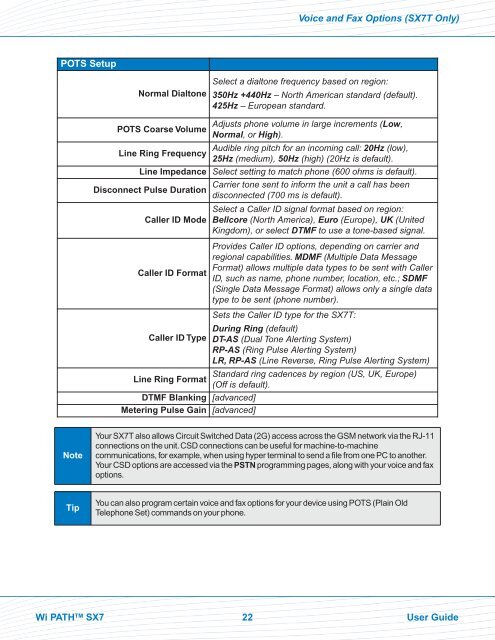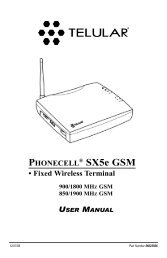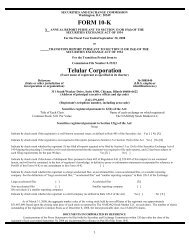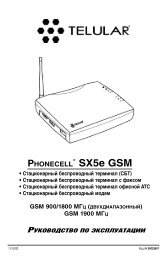56038502 HSDPA User Guide:Telular UG.qxd
56038502 HSDPA User Guide:Telular UG.qxd
56038502 HSDPA User Guide:Telular UG.qxd
You also want an ePaper? Increase the reach of your titles
YUMPU automatically turns print PDFs into web optimized ePapers that Google loves.
POTS Setup<br />
Note<br />
Tip<br />
Normal Dialtone<br />
POTS Coarse Volume<br />
Line Ring Frequency<br />
Select a dialtone frequency based on region:<br />
350Hz +440Hz – North American standard (default).<br />
425Hz – European standard.<br />
Adjusts phone volume in large increments (Low,<br />
Normal, or High).<br />
Audible ring pitch for an incoming call: 20Hz (low),<br />
25Hz (medium), 50Hz (high) (20Hz is default).<br />
Line Impedance Select setting to match phone (600 ohms is default).<br />
Disconnect Pulse Duration<br />
Caller ID Mode<br />
Caller ID Format<br />
Caller ID Type<br />
Voice and Fax Options (SX7T Only)<br />
Carrier tone sent to inform the unit a call has been<br />
disconnected (700 ms is default).<br />
Select a Caller ID signal format based on region:<br />
Bellcore (North America), Euro (Europe), UK (United<br />
Kingdom), or select DTMF to use a tone-based signal.<br />
Provides Caller ID options, depending on carrier and<br />
regional capabilities. MDMF (Multiple Data Message<br />
Format) allows multiple data types to be sent with Caller<br />
ID, such as name, phone number, location, etc.; SDMF<br />
(Single Data Message Format) allows only a single data<br />
type to be sent (phone number).<br />
Sets the Caller ID type for the SX7T:<br />
During Ring (default)<br />
DT-AS (Dual Tone Alerting System)<br />
RP-AS (Ring Pulse Alerting System)<br />
LR, RP-AS (Line Reverse, Ring Pulse Alerting System)<br />
Standard ring cadences by region (US, UK, Europe)<br />
Line Ring Format<br />
(Off is default).<br />
DTMF Blanking [advanced]<br />
Metering Pulse Gain [advanced]<br />
Your SX7T also allows Circuit Switched Data (2G) access across the GSM network via the RJ-11<br />
connections on the unit. CSD connections can be useful for machine-to-machine<br />
communications, for example, when using hyper terminal to send a file from one PC to another.<br />
Your CSD options are accessed via the PSTN programming pages, along with your voice and fax<br />
options.<br />
You can also program certain voice and fax options for your device using POTS (Plain Old<br />
Telephone Set) commands on your phone.<br />
Wi PATH TM SX7 22 <strong>User</strong> <strong>Guide</strong>










